Last Updated on October 6, 2025 by shawnshealth
Build functional strength for seniors with 10 essential exercises—boost mobility, reduce fall risk, and feel confident in just weeks.
Functional Strength for Seniors: 10 Essential Exercises for Daily Life
Functional strength for seniors is all about building the muscles and coordination you need to handle everyday activities safely and efficiently. For seniors, it’s not just about lifting weights — it’s about moving confidently, staying independent, and reducing the risk of falls. Many older adults underestimate the exercise they’re already doing in daily life, but simple, targeted movements can make a big difference.
Before we dive into the article, you might find it helpful to check out our Senior Fitness Guide
—a foundational resource for safe, progression-aware movement.
💡 Fast Facts: Functional Fitness for Seniors
🏋️♂️ What Is Functional Strength for Seniors?
- Functional strength = ability to perform daily tasks safely and efficiently
- Trains multiple muscle groups for real-life movement
- Examples: climbing stairs, lifting groceries, reaching overhead
💪 Top Functional Exercises for Seniors
- Sit-to-stand: builds leg and core strength
- Step-ups: improves balance and coordination
- Wall push-ups: strengthens upper body with low strain
🪑 Can Chair Exercises Build Functional Strength?
- Yes—ideal for low-impact training
- Seated leg extensions: support knee health
- Seated rows: improve posture and upper back strength
✅ Benefits of Functional Strength Training
- Boosts balance and mobility
- Supports independence and confidence
- Reduces fall risk with just 3–4 sessions/week
🛡️ Looking to build lasting strength, mobility, and confidence as you age? Don’t miss our comprehensive guide: Senior Fitness: 15 Essential Principles for Strength, Mobility & Healthy Aging. This foundational post covers everything from safe strength training and balance drills to mindset, recovery, and nutrition—empowering older adults to stay active, independent, and injury-free.
🛒 Quick Tip: Looking for fitness gear? Browse top-rated equipment on Amazon to power up your workouts fast 💪
As an Amazon Associate, I earn from qualifying purchases. This means I may receive a commission if you purchase through links on this site, at no extra cost to you.
Table of Contents
Medical Disclaimer: This content is for informational purposes only and is not a substitute for professional medical advice, diagnosis, or treatment.
Disclaimer: As an Amazon Associate, I earn from qualifying purchases—at no extra cost to you.
What is Functional Strength?
Functional strength refers to the ability to perform everyday movements safely, efficiently, and with minimal effort. Unlike traditional strength training that focuses on isolated muscles, functional strength trains multiple muscle groups at once.
Examples include:
- Pushing a shopping cart
- Lifting a grandchild
- Reaching overhead for objects
- Climbing stairs

Why Functional Strength for Seniors Matters
Functional strength is essential for seniors because it:
- Supports independence – Makes daily tasks easier and safer.
- Improves balance and stability – Reduces fall risk.
- Enhances mobility – Keeps joints flexible and muscles engaged.
- Boosts confidence – Encourages active lifestyles and participation in social activities.
🪑New to exercise or easing back in? Our Beginner Chair Exercises for Seniors offer gentle, progression-aware movements designed for comfort, safety, and confidence—no standing required.
🧠For broader guidance on staying active as you age, the CDC’s Physical Activity for Older Adults outlines key recommendations, safety tips, and benefits of regular movement.
10 Essential Functional Strength Exercises for Seniors
📈 Before jumping into the 10 essential exercises, take a moment to review the Sets, Reps & Progression Guide below—it’s your roadmap for tailoring each movement to your current level and knowing when to safely level up. Once you’re familiar with how to structure your routine, explore the exercises below to build real-world strength, mobility, and confidence.
🏋️♂️ Sets, Reps & Progression Guide for Senior Functional Strength
⏳ Rest Between Sets: Take 1–2 minutes of rest between each set. This gives your body time to recover and helps maintain good form throughout your routine. There’s no need to rush—steady, consistent practice is far more effective than pushing through quickly. Think of each session as a chance to build strength with care and confidence.
| Level | Reps per Exercise | Sets | Progression Cues |
|---|---|---|---|
| 🟢 Beginner | 8–10 reps | 1–2 sets | Slight challenge with good form |
| 🔵 Intermediate | 10–12 reps | 2–3 sets | Controlled movement, minimal fatigue |
| 🔴 Advanced | 12–15 reps | 3–4 sets | Ready for resistance or variation |
🔁 When to Progress
- ✅ You complete all reps and sets with ease and good form
- ✅ You recover quickly and feel ready for more
- ✅ You’ve maintained consistency for 2+ weeks at current level
⏫ How to Progress Safely
- 🔹 Increase reps first (e.g., from 10 to 12)
- 🔹 Then add a set (e.g., from 2 to 3 sets)
- 🔹 Finally, add light resistance (bands, weights, household items)
- 🔹 For balance moves, reduce support (e.g., less hand contact with chair or wall)
📈 Ready to put your sets and reps into action? Now that you know how to structure your routine and progress safely, let’s dive into 10 essential functional strength exercises designed to help seniors move confidently through daily life. Each movement targets real-world tasks like standing, reaching, and lifting—with clear instructions and built-in progression.
1. Sit-to-Stand from a Chair
- Improves leg and core strength.
- Start with a sturdy chair, feet flat, and hands optional for support.
- Slowly stand up and sit back down, repeat 10–15 times.
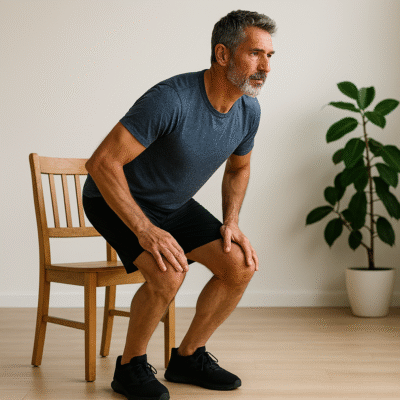
2. Step-Ups on a Low Platform
- Strengthens legs and improves balance.
- Use a safe step or low bench; step up with one foot, then the other, and step down.
- Repeat 10–12 times per leg.
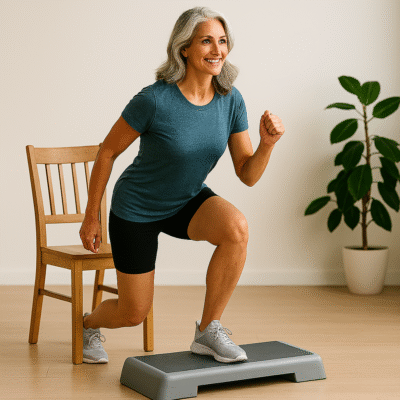
3. Wall Push-Ups
- Works chest, shoulders, and arms with minimal strain.
- Stand a few feet from a wall, hands flat, elbows bent; push away from the wall and return.
- Repeat 10–15 times.
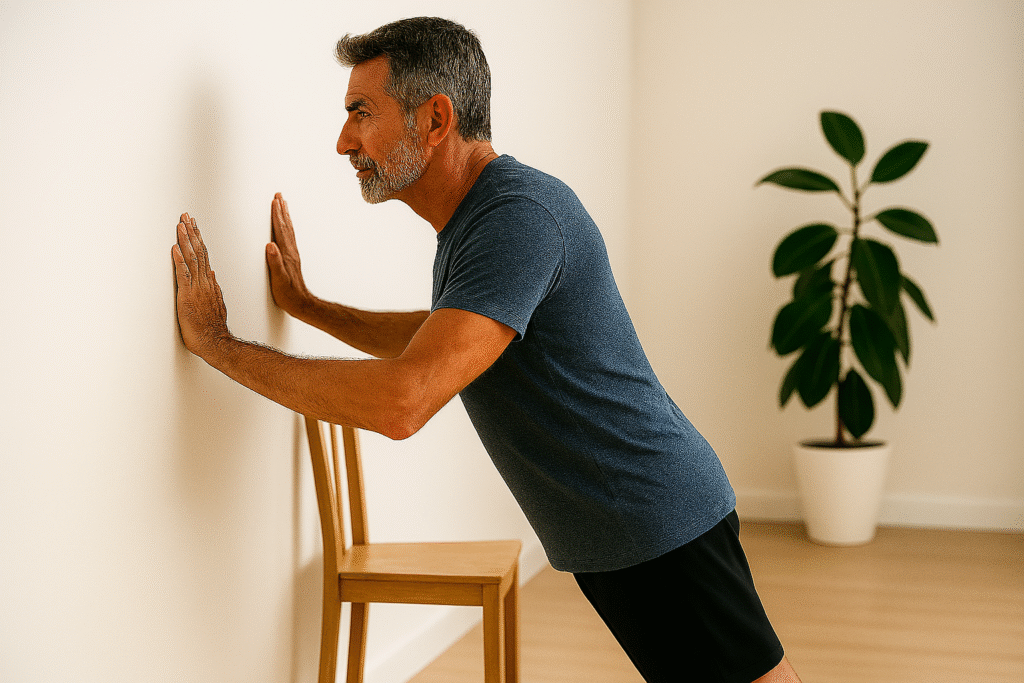
4. Overhead Reach with Light Weights
- Strengthens shoulders and improves mobility for overhead tasks.
- Hold light dumbbells or water bottles, reach overhead, lower slowly.
- Repeat 10–12 times.
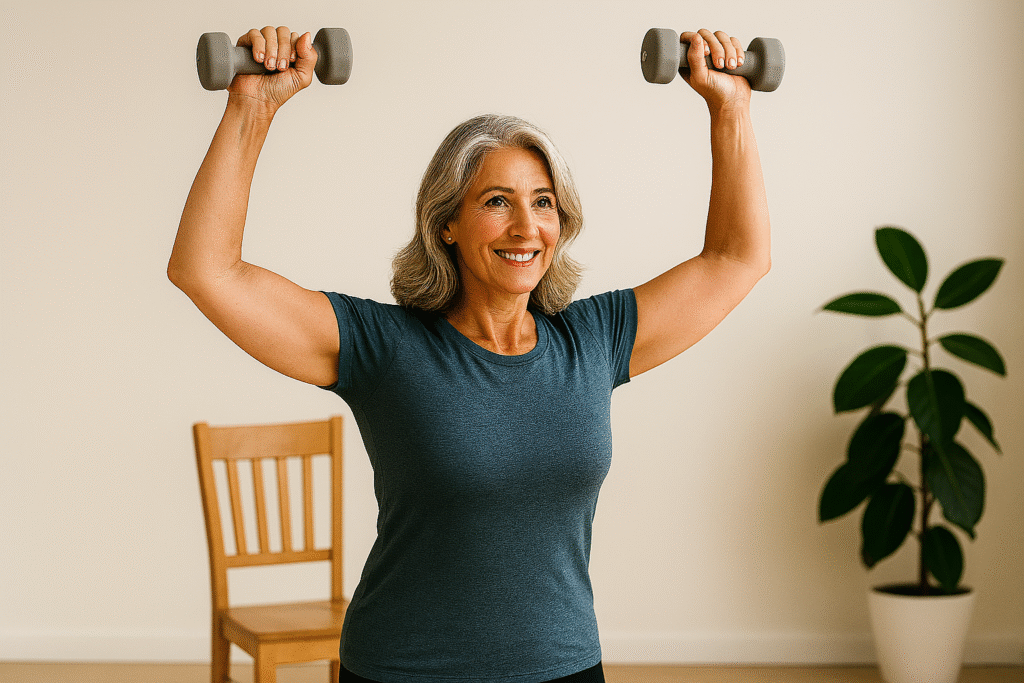
5. Heel Raises
- Improves balance and strengthens calves.
- Stand behind a chair for support; rise onto toes, lower slowly.
- Repeat 12–15 times.
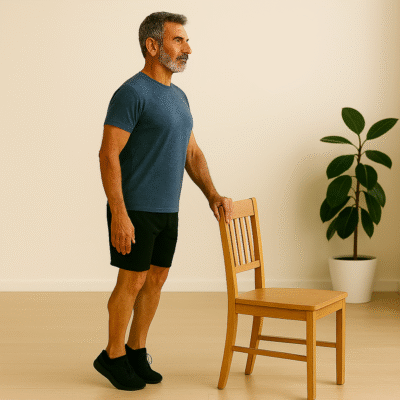
6. Seated Leg Extensions
- Strengthens quadriceps and supports knee health.
- Sit upright, extend one leg straight out, hold 2–3 seconds, then lower.
- Repeat 10–12 times per leg.
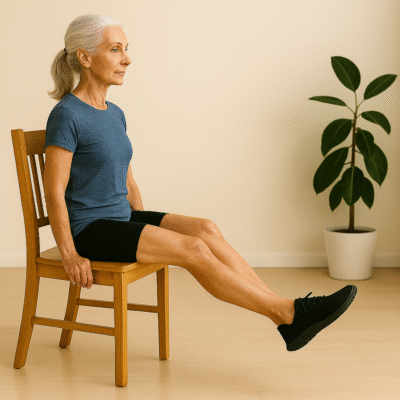
7. Side Leg Lifts
- Strengthens hip abductors and improves lateral stability.
- Stand or sit, lift one leg out to the side, hold briefly, then lower.
- Repeat 10–12 times per leg.
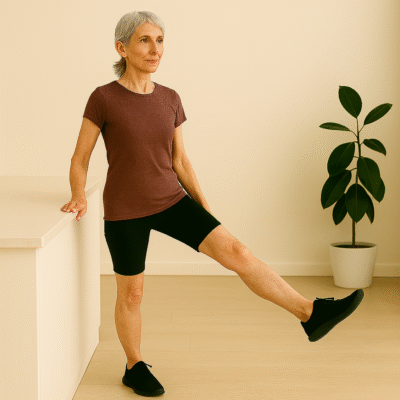
8. Seated or Standing Rows with Resistance Bands
- Strengthens upper back and improves posture.
- Wrap a band around a stable object, pull towards the torso, return slowly.
- Repeat 10–15 times.
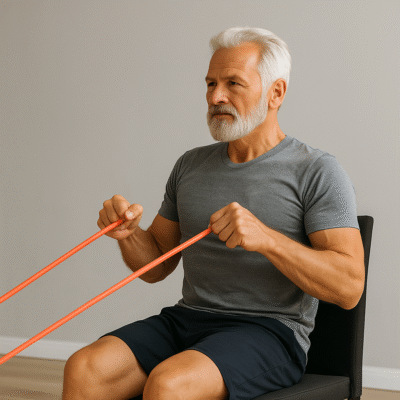
9. Marching in Place
- Enhances coordination, cardiovascular health, and leg strength.
- Lift knees alternately, swing arms naturally, 1–2 minutes per session.
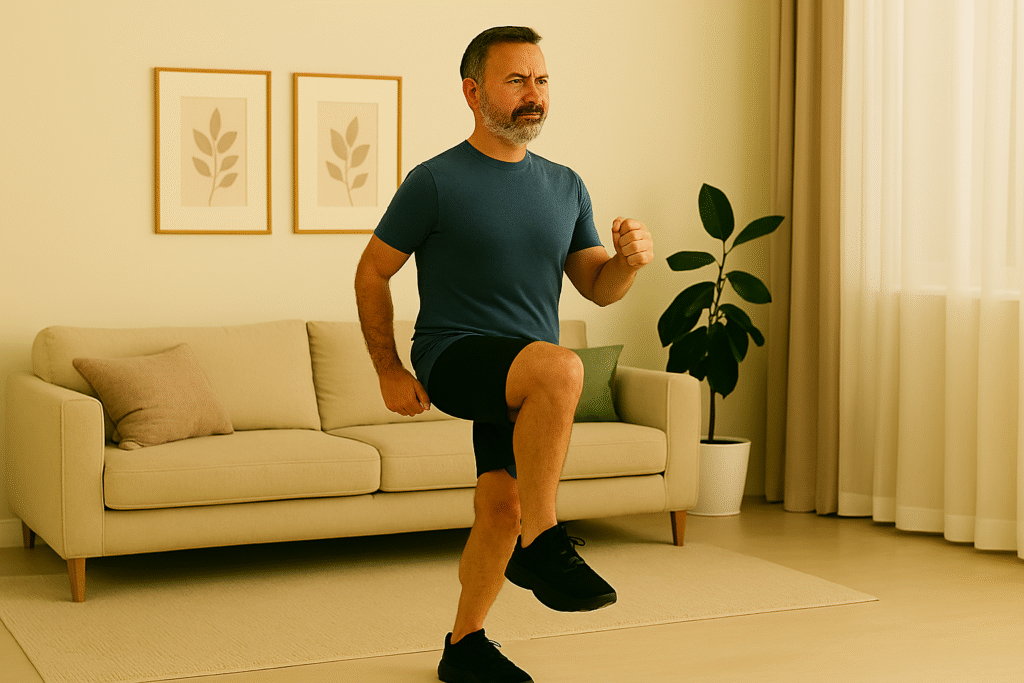
10. Carrying Light Objects (Functional Load)
- Simulates daily tasks like groceries or laundry.
- Hold a light object in each hand and walk a short distance safely.
- Focus on posture and controlled movement.
🧺 Want to carry with confidence? Learn how farmer strength builds real-world power through simple, safe movements. Explore the full guide.

Tips for Safely Building Functional Strength
- Start slowly and progress gradually.
- Focus on good form over quantity.
- Use chairs or walls for support if needed.
- Incorporate exercises 3–4 times per week.
- Stay hydrated and rest between sessions.
- Consult your doctor if you have existing health conditions.
🧺 Already Stronger Than You Think Before diving deeper into structured exercises, it’s worth celebrating the movement you’re already doing. Everyday tasks like carrying groceries, climbing stairs, or reaching overhead aren’t just chores—they’re workouts in disguise. Discover 10 surprisingly effective daily activities that count as exercise in our post: Everyday Activities That Count as Workouts. You might be building functional strength without even realizing it.
Conclusion
Functional strength is essential for seniors to maintain independence, prevent falls, and handle daily activities with confidence. By practicing these 10 essential exercises regularly, seniors can improve strength, balance, and mobility — all while staying safe and active.
🔥 Gear to Help You Achieve Your Health and Fitness Goals 💪
If you’re looking for tools to enhance your fitness journey, check out this. Explore top-rated fitness gear on Amazon to enhance your workouts. Check out the latest picks here! 🛒 to support your workouts and progress.
🚀 Find equipment designed to boost strength, endurance, and overall performance!
⚠️ Short disclaimer: As an Amazon Associate, I earn from qualifying purchases.
🧭Want to keep building strength safely from home?
These curated routines offer step-by-step guidance for every level—from gentle seated movements to more dynamic chair-based workouts. Whether you’re just starting out or ready to challenge yourself, you’ll find a routine that fits your comfort and goals. Explore the full series below:
- Beginner Chair Exercises for Seniors – Gentle movements to build foundational strength and confidence.
- Intermediate Chair Exercises for Seniors – A balanced mix of seated moves for progression.
- Advanced Chair Exercises for Seniors – Dynamic routines for seniors ready to level up safely.
- NIH Senior Health: Older Adults Exercise Toolkit – Trusted guidance from the National Institute on Aging.
🎥 Try a Full-Body Functional Strength Routine
Learn five foundational movements that support everyday strength and independence.
🧠 Want to understand what strength really means—beyond reps and routines? Explore What Is Strength to discover the six essential elements that define true power, inside and out.
❓ FAQ – Functional Strength for Seniors
What is functional strength and why does it matter for seniors?
- It’s the ability to perform everyday tasks—like standing, reaching, and lifting—with ease and safety.
- Functional strength supports independence, reduces fall risk, and improves confidence in daily movement.
- Unlike gym workouts, it focuses on real-world mobility and coordination.
How often should seniors do functional strength exercises?
- 3–4 sessions per week is ideal for steady progress and recovery.
- Consistency matters more than intensity—daily movement builds lasting strength.
- Rest days are important, but gentle mobility work can still be done.
Do I need equipment to get started?
- No—bodyweight movements like sit-to-stand and wall push-ups are highly effective.
- Household items (water bottles, towels, chairs) can double as training tools.
- Resistance bands or light weights can be added later for progression.
Can functional exercises help with joint pain or stiffness?
- Yes—low-impact movements improve circulation and joint mobility.
- Chair-based or supported exercises reduce strain while building strength.
- Always prioritize form and comfort; modify as needed.
How do I know when it’s time to progress?
- You complete all reps and sets with ease and good form.
- You recover quickly and feel ready for more challenge.
- Progress by adding reps, sets, or light resistance gradually.
What if I feel too tired or sore after a session?
- That’s normal—especially when starting out. Rest and hydration help.
- Reduce volume next session and focus on gentle movement.
- Track how you feel over time; soreness should fade with consistency.
Can I do these exercises at home without supervision?
- Yes—these routines are designed for safe, independent practice.
- Use a sturdy chair or wall for support when needed.
- Start slow, follow clear instructions, and listen to your body.
How long before I notice results?
- Most seniors feel stronger and more confident within 4–6 weeks of consistent practice.
- Improvements in balance, posture, and energy often show up first—sometimes within days.
- Small wins matter: standing up easier, walking farther, or feeling steadier are all signs of progress.
My grace is all you need, for My power is the greatest when you are weak. – 2 Corinthians 12:9




